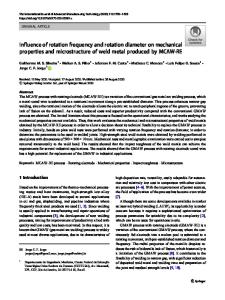Effect of Weld Parameters on the Microstructure of Aluminum-Copper Joints Produced by Flash Welding
- PDF / 3,257,522 Bytes
- 13 Pages / 593.972 x 792 pts Page_size
- 81 Downloads / 336 Views
JMEPEG https://doi.org/10.1007/s11665-020-05035-x
Effect of Weld Parameters on the Microstructure of Aluminum-Copper Joints Produced by Flash Welding A. Shafiei, V. Yerevanian, and D.M. Maijer (Submitted April 19, 2020; in revised form June 21, 2020) The effects of operational conditions on dissimilar Al-Cu flash welded joint quality have been studied using a series of industrial welding experiments. Macro- and microstructural analyses of dissimilar aluminumcopper joints produced by flash butt welding are performed in the present work. Various process conditions including standard and non-standard operational conditions were assessed during the welding experiments. Optical and scanning electron microscopy and electron dispersive x-ray spectroscopy are used to investigate and assess the metallurgical joints created through this process. For suboptimal process conditions, voids (5 mm wide, 1 mm deep) were observed at the joint interface. Some of the voids contained remnants of molten metal while some were empty. Al-Cu intermetallic compounds at the joint area were investigated, and their chemical compositions are determined. The profile of the joint interface was observed to be wavy which is attributed to the voids on the copper side and insufficient material flow of the copper during the upset. The effects of welding parameters on the waviness of the interfaces are investigated. The results show that the waviness of the interface increases with increasing the heat intensity (heat/joint area). No correlation was observed between the flashing speed and the waviness of the interfaces. Keywords
aluminum, copper, flash butt welding, intermetallics, microstructure, multi-material joining
1. Introduction Flash welding (FW) is an automatic resistance welding process which is used to weld various substrates including wires, bars, rods and tubes (Ref 1-3). During this process, most of the heat which is required to create the weld joint is generated by resistance heating; however, electric arcs between the surfaces being joined can also provide significant heating in the joint area (Ref 1-3). FW is a multiple-stage welding process (Ref 3-5) where the components being joined are clamped by dies (which are called platens) in an end-to-end position. Initially, the components are set apart by a suitable air gap. Then a low voltage is applied and the work pieces are slowly brought together. When the joint surfaces touch each other, current flows and rapid melting and vaporization of the contact points ensue followed by a short period of arcing between surfaces (Ref 3-5). This step of the process is called flashing, and all of the heat required for welding is provided in this step. During flashing, the joint surfaces are melted and surface irregularities/oxides are removed and a molten metal layer is formed on the components surfaces that are being joined (Ref 3-5). Flashing continues until the metal in proximity to the weld surfaces reaches an appropriate temperature (e.g., forging temperature) to facilitate adequate deformation during the
Data Loading...











